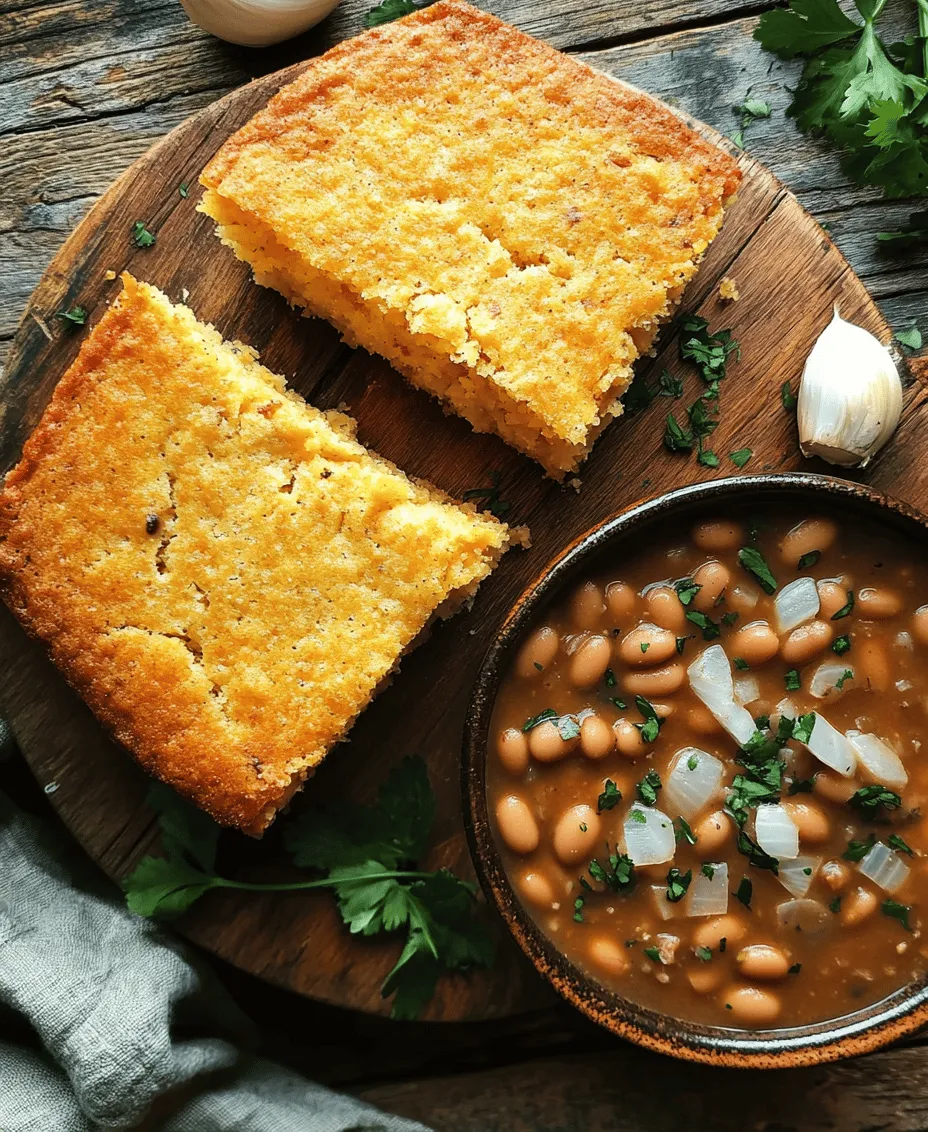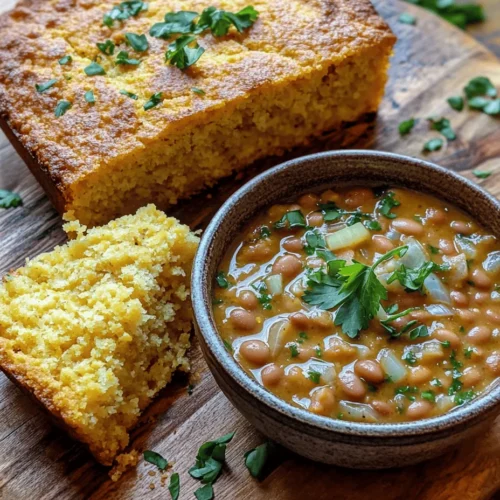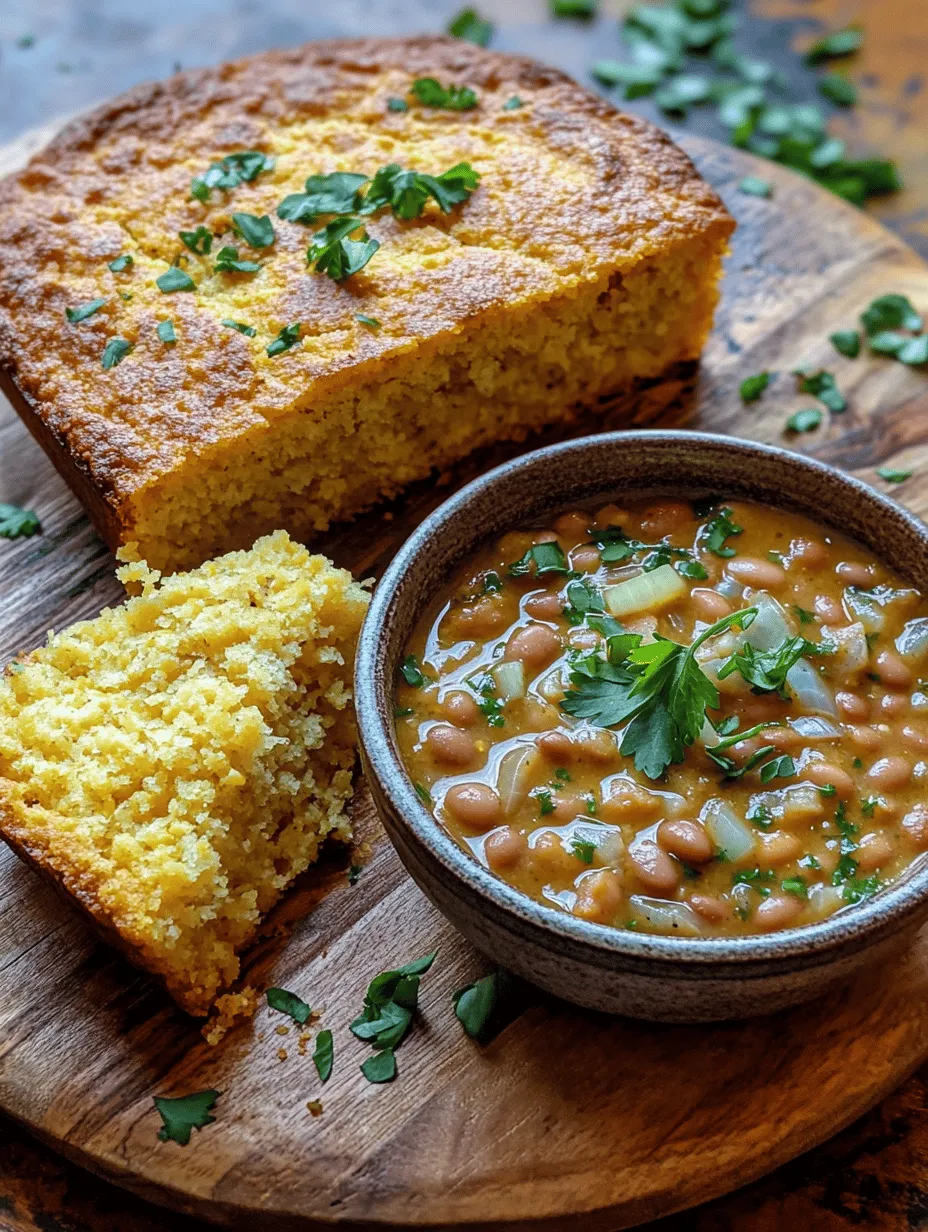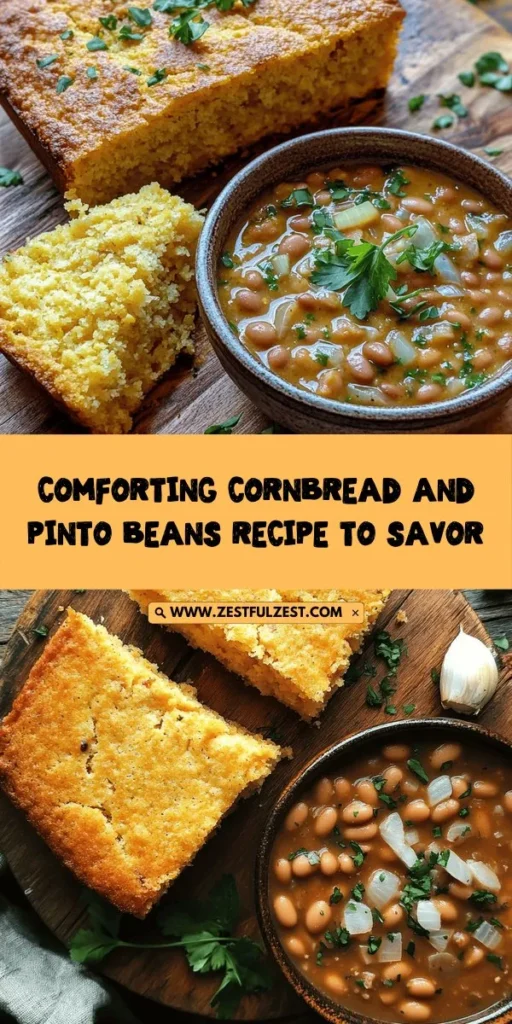Introduction
When it comes to comfort food, few dishes can rival the heartwarming combination of cornbread and pinto beans. This delightful meal not only warms the soul but also fills the stomach, making it an ideal choice for lunch or dinner. Rich in flavor and history, cornbread and beans have long been staples in various cuisines, particularly in Southern and Southwestern American cooking. They embody the essence of hearty, home-cooked meals, often associated with family gatherings, community events, and festive occasions.
Cornbread, with its golden crust and moist, tender interior, perfectly complements the creamy, earthy flavors of pinto beans, which are often simmered to perfection with a mix of spices and aromatics. This dish is not only comforting but also incredibly nutritious. Pinto beans are an excellent source of protein, fiber, and essential vitamins, making them a smart choice for anyone looking to eat healthily. The simplicity of the recipe ensures that it is accessible for home cooks of all skill levels, allowing everyone to enjoy this timeless dish.
In this article, we’ll delve into the essential ingredients that make up this classic meal and guide you through the preparation of both the pinto beans and the cornbread. Whether you’re a seasoned cook or a beginner in the kitchen, you’ll find that creating this comforting dish is straightforward and rewarding.
Understanding the Ingredients
Key Ingredients in Cornbread
To make the perfect cornbread, you need a few key ingredients that work in harmony to create a light, fluffy texture and a rich flavor profile. The most important ingredient is cornmeal, which is ground from dried corn and gives cornbread its signature taste and texture. The type of cornmeal you use can impact the final product; for the best results, opt for medium to fine ground cornmeal, which will yield a tender crumb.
Buttermilk is another essential ingredient that not only adds a slight tanginess but also reacts with baking soda to create a light and airy cornbread. If you don’t have buttermilk on hand, you can easily make a substitute by mixing regular milk with a splash of vinegar or lemon juice and letting it sit for about five minutes.
Other ingredients include:
– Egg: Provides structure and moisture while helping to bind the ingredients together.
– Butter: Adds richness and flavor, contributing to the overall moistness of the cornbread.
– Sugar: While not always necessary, a touch of sugar enhances the sweetness and balances the savory notes.
– Baking Powder and Baking Soda: These leavening agents are crucial for achieving the desired rise and fluffiness.
– Salt: Enhances the flavors of the other ingredients and rounds out the dish.
Ingredients Used for Pinto Beans
Pinto beans are the star of this dish, known for their creamy texture and mild flavor. When it comes to choosing your beans, you have the option of using dried pinto beans or canned beans. While canned beans offer convenience, dried beans are often more economical, and they allow for greater control over the cooking process. Dried beans also have a firmer texture and can absorb more flavors from the cooking liquid.
For the best flavor, you’ll want to enhance your pinto beans with a few aromatics and spices:
– Onion and Garlic: These form the flavor base of the dish. Sautéing them first releases their natural sweetness and depth.
– Cumin and Smoked Paprika: These spices add warmth and a hint of smokiness, elevating the overall flavor profile. Cumin is particularly popular in Southwestern and Mexican cuisines, making it a perfect complement for pinto beans.
– Vegetable Broth: Cooking the beans in vegetable broth instead of plain water infuses them with additional flavor, making the final dish much more satisfying.
Preparing the Pinto Beans
Step-by-Step Instructions on Soaking and Preparing Dried Pinto Beans
Soaking dried pinto beans is a crucial step that not only reduces cooking time but also helps to soften the beans, ensuring they cook evenly. Here’s how to prepare your beans:
1. Rinse the Beans: Start by placing the dried pinto beans in a colander and rinsing them under cold running water. This step removes any dirt or debris.
2. Soak the Beans: Transfer the rinsed beans to a large bowl and cover them with plenty of water—at least three inches above the beans. Allow them to soak overnight. If you’re short on time, you can opt for a quick soak method: boil the beans in water for about two minutes, then remove from heat and let them sit for an hour.
3. Drain and Rinse: After soaking, drain the beans and rinse them again under cold water. This removes any indigestible sugars that may cause gas.
Techniques for Sautéing Onions and Garlic to Enhance Flavor
Once your beans are prepped, it’s time to build the flavor base. Sautéing onions and garlic is a simple technique that enhances the overall taste of your pinto beans:
1. Heat the Oil: In a large pot, heat a tablespoon of olive oil or butter over medium heat. Allow it to warm until it’s shimmering but not smoking.
2. Add the Onions: Dice one medium onion and add it to the pot. Sauté the onions for about 5 minutes, stirring occasionally, until they become translucent and fragrant.
3. Incorporate Garlic: Mince three cloves of garlic and add them to the pot. Sauté for an additional minute, being careful not to let the garlic burn, as it can develop a bitter taste.
Cooking the Beans
With your flavor base ready, it’s time to cook the beans:
1. Add the Beans and Liquid: Add the soaked and drained pinto beans to the pot along with enough vegetable broth to cover the beans by about two inches. This will ensure the beans have plenty of liquid to absorb as they cook.
2. Season the Beans: Stir in the cumin, smoked paprika, and a pinch of salt. Seasoning the beans early on allows them to absorb the spices as they simmer.
3. Simmer: Bring the mixture to a gentle boil, then reduce the heat to low. Cover the pot and let the beans simmer for about 1.5 to 2 hours, or until they are tender. Check periodically and add more broth or water if needed to keep the beans submerged.
4. Final Seasoning: Once the beans are cooked through, taste and adjust the seasoning as necessary. Adding a little more salt and pepper can enhance the flavors even further.
With your pinto beans simmering away, the next step is to turn your attention to the cornbread, where the magic of combining these two comforting components truly comes together.
Stay tuned for the detailed steps on making the perfect cornbread from scratch, where we will explore the techniques that ensure a fluffy and flavorful result that pairs beautifully with your beans.

Preheating the Oven and Preparing the Baking Pan
Before diving into the delightful process of making cornbread and pinto beans, it’s crucial to prepare your oven and baking pan properly. Preheat your oven to 400°F (200°C). This temperature ensures a nice, even bake that is essential for achieving that classic golden brown crust on your cornbread.
While the oven is preheating, prepare your baking pan. A 9-inch square or round cast-iron skillet is ideal for cornbread, as it helps create a crispy bottom while keeping the interior light and fluffy. If you don’t have a cast-iron skillet, a non-stick baking dish will work just fine. Grease the pan generously with butter or cooking spray to prevent sticking. For an extra touch of flavor, consider using bacon grease or oil infused with herbs. This will enhance the overall taste of the cornbread, giving it a delightful depth.
Importance of Mixing Wet and Dry Ingredients Carefully
One of the keys to achieving perfect cornbread lies in the careful mixing of wet and dry ingredients. Begin by combining your dry ingredients—cornmeal, flour, baking powder, sugar, and salt—in a large mixing bowl. It’s essential to mix these thoroughly to ensure that the baking powder is evenly distributed, which will help the cornbread rise uniformly.
In a separate bowl, whisk together the wet ingredients—milk, eggs, and melted butter—until well combined. When you combine the wet and dry mixtures, do so gently. Overmixing can develop gluten in the flour, leading to a dense and tough cornbread rather than the light and fluffy texture we desire. Stir just until the ingredients are combined, and you see no dry flour. A few lumps are perfectly acceptable.
Baking Tips for Achieving a Golden Brown Crust and Fluffy Interior
To achieve that coveted golden brown crust while ensuring a fluffy interior, there are a few baking tips to keep in mind:
1. Use a Preheated Skillet: If using a cast-iron skillet, place it in the oven while it preheats. When you pour the batter into the hot skillet, it will sizzle, creating a beautiful crust.
2. Don’t Open the Oven Door: Resist the urge to open the oven door while the cornbread is baking, especially during the first 20 minutes. This will keep the heat consistent and allow the cornbread to rise properly.
3. Check for Doneness: Baking time generally ranges from 20 to 25 minutes. To check for doneness, insert a toothpick into the center of the cornbread. If it comes out clean or with a few crumbs attached, it’s ready. If it comes out wet, give it a few more minutes.
4. Cool Before Serving: Allow the cornbread to cool in the pan for about 10 minutes before transferring it to a wire rack. This cooling period helps set the texture and makes it easier to slice without crumbling.
Variations and Customizations for Cornbread
While the classic cornbread recipe is delightful on its own, there are numerous ways to customize it to suit your taste:
– Herbs: Fresh herbs like chopped chives, rosemary, or thyme can add an aromatic quality to the cornbread. Simply fold in about 1/4 cup of fresh herbs to the batter before baking.
– Cheese: For a savory twist, consider adding shredded cheese like cheddar or pepper jack. This adds a creamy texture and enhances the flavor profile. About 1 cup of cheese mixed into the batter works wonderfully.
– Spices: To give your cornbread a bit of a kick, add spices such as cayenne pepper, smoked paprika, or even cumin. A teaspoon or two of your favorite spice can transform the flavor while still keeping the comforting essence of cornbread.
– Sweet Additions: If you prefer a sweeter cornbread, incorporate ingredients like honey, maple syrup, or even fresh corn kernels. These additions will complement the natural sweetness of the cornbread and pair well with the savory pinto beans.
Serving Suggestions
Cornbread and pinto beans make a hearty and satisfying meal, but there are many ways to enhance your dining experience:
– Together on the Plate: Serve the warm cornbread alongside a generous scoop of pinto beans. The creamy texture of the beans complements the fluffy cornbread perfectly. You can even crumble the cornbread on top of the beans for an interesting texture combination.
– Salads: A crisp, fresh salad makes an excellent accompaniment to this dish. Consider a simple green salad with vinaigrette or a tangy coleslaw to add a refreshing crunch.
– Pickled Vegetables: The acidity from pickled vegetables can balance the richness of the cornbread and beans. Try serving with pickled jalapeños, red onions, or even pickled radishes for an added zing.
– Hot Sauce: For those who enjoy a bit of heat, a drizzle of your favorite hot sauce can elevate the dish. The spices will enhance the flavors of both the cornbread and pinto beans.
– Creative Presentation: For gatherings, consider serving cornbread in muffin form. This makes for easy portioning and adds a fun twist to your presentation. Pair them with individual portions of pinto beans in small bowls or jars for a rustic yet appealing aesthetic.
Nutritional Benefits of Cornbread and Pinto Beans
This dish isn’t just comforting and delicious—it’s also packed with nutritional benefits:
– Pinto Beans: One of the standout ingredients, pinto beans are a powerhouse of nutrition. They are high in protein and fiber, making them an excellent option for vegetarians and anyone looking to increase their protein intake without relying on meat. One cup of cooked pinto beans contains about 15 grams of protein and a significant amount of dietary fiber, which aids in digestion and promotes heart health.
– Cornbread: While cornbread is primarily a source of carbohydrates, it also provides essential nutrients such as B vitamins, iron, and magnesium. When made with whole cornmeal, it retains more fiber and nutrients compared to refined flour options.
– Balance of Flavors and Nutrition: Together, cornbread and pinto beans create a balanced meal that is both satisfying and nourishing. The combination of protein, fiber, and carbohydrates makes it a great option for any meal of the day.
Cultural Significance
Cornbread and pinto beans hold a special place in American cuisine, especially in Southern and Southwestern regions. Historically, cornbread emerged as a staple in Native American diets and quickly became integrated into the culinary practices of settlers. Pinto beans, native to the Americas, were cultivated and consumed by indigenous populations long before they became popular in mainstream cuisine.
Regional variations abound; for instance, in the South, cornbread is often sweetened and served as a side dish, while in the Southwest, it may be more savory and paired with spicy flavors. Each region has its own unique spin on how to enjoy this comforting dish.
Personal anecdotes often accompany meals like cornbread and beans. Many people recall family gatherings where cornbread was served alongside a pot of beans, creating a warm and inviting atmosphere. Sharing these meals often fosters connections, making it a cherished food in many households.
Conclusion
The journey of making cornbread and pinto beans is one filled with warmth, flavor, and tradition. This dish not only brings comfort to your table but also serves as a reminder of the rich culinary heritage that it represents. With its versatility, you can easily modify the recipe to suit your taste, whether you prefer it sweet or savory.
Cornbread and pinto beans are more than just food; they are a way to connect with family and friends, sharing stories and memories over a satisfying meal. We encourage you to try making this recipe and experience the joy and comfort that it brings to your dining table. Whether it’s a casual weeknight dinner or a special gathering, cornbread and pinto beans are sure to delight and nourish all who partake. Enjoy!



